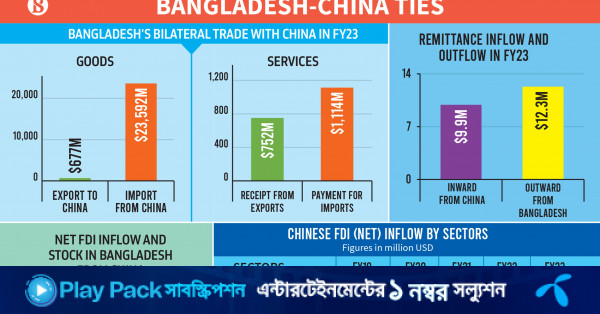Dhaka looks beyond free trade in ties with Beijing


CEPA talks, 17 MoUs to feature PM’s China visit
Infograph: TBS
“>
Infograph: TBS
Bangladesh and China are moving towards a Comprehensive Economic Partnership Agreement (CEPA) aiming to significantly boost trade and investment, replacing talks on a Free Trade Agreement (FTA).
Formal negotiations could be announced during Prime Minister Sheikh Hasina’s visit to China on 8-11 July, according to commerce, finance and foreign ministry officials.
This development follows closely on the heels of Bangladesh’s recent agreement to start CEPA negotiations with India late last month. Also, Bangladesh initiated discussions with Japan for an Economic Partnership Agreement (EPA) last year.
Based on the findings of a joint feasibility study conducted on FTA, Bangladesh and China are now considering the CEPA approach to boosting economic ties.
Highlights: TBS
“>
Highlights: TBS
An FTA focuses on reducing tariffs and trade barriers on goods while a CEPA covers services, investment, intellectual property rights, government procurement, disputes, and regulatory aspects.
Bangladesh is pursuing a multi-pronged trade strategy to secure its economic future beyond LDC status in 2026, focusing on attracting investment, securing technology support, and fostering broader economic cooperation, alongside duty-free export benefits, commerce officials said.
On Wednesday, the prime minister held a meeting with the top officials of various ministries to finalise various agreements during her visit to China.
Experts said any trade agreement, whether an FTA or a CEPA, should be accompanied by a surge in Chinese investment in Bangladesh.
“Bangladesh needs huge investment in man-made fibre, in which China is the world leader. China is facing adversity in exports to the US and around the world. They can also invest in our non-RMG sector and take advantage of export opportunities from Bangladesh,” said Prof MA Razzaque, chairman of Research and Policy Integration for Development (RAPID).
According to ministry officials, China has expressed its readiness to enhance import of high-quality products from Bangladesh.
To solidify economic cooperation, 17 Memorandums of Understanding (MoUs) could be signed, and joint announcements on 14 issues may be made during the prime minister’s visit to China.
Al Mamun Mridha, secretary-general of the Bangladesh-China Chamber of Commerce and Industry, told TBS that Chinese investment and trade in ASEAN countries, such as Vietnam, have significantly risen since China signed an FTA with ASEAN.
“If Bangladesh signs a CEPA or FTA with China, investment will also increase here,” he said.
“Chinese companies are keen on investing in 20 promising sectors in Bangladesh, including ICT, textiles, automobiles, leather, and solar. Chinese delegations visit every month to assess the investment climate and facilities in these sectors,” Mridha said.
“We are optimistic that Chinese investment will grow with the expansion of bilateral trade and investment cooperation,” he added.
One of the MoUs expected to be signed during the PM’s visit is “Comprehensive Trade and Economic Cooperation”.
“The parties will aim to enhance trade and investment through bilateral cooperation in mutually agreed sectors,” the draft MoU, seen by TBS, reads. It names jute, agribusiness, ICT, light engineering, leather goods, apparel, research, and educational services among the potential areas of cooperation.
Furthermore, the MoU will encompass discussions on economic reforms and cooperation initiatives to promote bilateral trade and investment.
The Bangladesh Bank is expected to sign another MoU with the China Banking and Insurance Regulatory Commission for joining the China-led mBridge, a cross-border digital currency initiative.
Should Bangladesh join mBridge, it will gain the ability to conduct trade in its own currency with other members: China, Hong Kong, Thailand, and the United Arab Emirates.
The Economic Relations Division may sign a MoU titled “Cooperation in the Field of Infrastructure and Engineering Construction” to secure Chinese loans for various projects, including railways.
Another agreement could be signed between Deshbandhu Group, Chemtex, and China National Chemical Engineering (CNCEC) to invest around $400 million in the largest PSF and PET bottle and textile-grade factory in the Mongla Economic Zone.
Once operational, the China-funded factory is expected to export products worth $1 billion annually.
Other agreements will cover investment in the digital economy, and the 9th Bangladesh-China Friendship Bridge Project.
Additionally, Bangladesh has proposed constructing a railway network throughout the southern region and establishing a special economic zone for Chinese investors in Khulna.
During the PM’s visit, several announcements may be made, including the start of negotiations on optimising the China-Bangladesh bilateral investment treaty and the approval of a project focused on water supply, sanitation, drainage, solid waste, and faecal sludge management for small-sized municipalities in Bangladesh.
Bangladesh has requested $5 billion in budget support and $2 billion in trade support from China. A final decision on these requests may be made during the prime minister’s visit.
The Bangladesh Investment Development Authority (Bida) and the Bangladesh Securities and Exchange Commission (BSEC) will host a
Prime Minister Sheikh Hasina will attend a day-long summit titled “Summit on Trade, Business, and Investment Opportunities between Bangladesh and China” in Beijing on 9 July.
Why CEPA instead of FTA?
Ministry officials said that Bangladesh’s main export product is readymade garments, where China is already a leading player. Therefore, there is limited potential to increase exports to China through an FTA. Instead, the government is focusing on attracting more Chinese investment to create jobs and boost exports.
Meanwhile, China, like India, is interested in signing a CEPA with Bangladesh that includes trade, investment, technology support, and other areas. Consequently, the two countries have agreed to convert the proposed FTA into a CEPA and will start negotiations this year.
China is one of Bangladesh’s major trade partners and its largest source of imports. Historically, Bangladesh has faced large trade deficits with China due to low export volumes.
According to the joint feasibility study on FTA which was initiated in October 2016, Bangladesh enjoys duty-free access to over 98% of Chinese tariff lines. However, Bangladesh’s exports to China have never reached $1 billion, while imports from China exceeded $26 billion in FY22 and were $23.59 billion in FY23.
Readymade garments make up about 44% of Bangladesh’s exports to China, which sells mainly industrial raw materials, intermediate goods, machinery and parts to Bangladesh.
Prof MA Razzaque, chairman of Research and Policy Integration for Development (RAPID), noted that 40% of Bangladesh’s imports from China benefit from duty-free status as raw materials for the export sector.
Prof Razzaque said, “There is evidence to suggest that FTAs with China will have a positive impact on GDP, exports, and imports.”
Speaking to TBS on 1 July, Prof Razzaque said a CEPA offers more comprehensive benefits than an FTA.
“Whatever the name [of the deal], it should be backed by Chinese investment. This investment should not be for our domestic market, but rather Chinese investment should come for the global export market,” he said.
From 2018-19 to the end of June 2023, Chinese net foreign direct investment (FDI) to Bangladesh totalled $1.95 billion, mostly in the power sector, with notable investments in textiles, construction, and trading.
According to a study, China has invested approximately $4.45 billion in Bangladesh’s infrastructures over the past decade through the Belt and Road Initiative.
Discussing technological advancements, Prof Razzaque said, “China is at the forefront of developing Fourth Industrial Revolution technologies, including artificial intelligence and robotics. Bangladesh would benefit from technology transfer through Chinese investment.”
However, he cautioned that Bangladesh would need a CEPA or FTA with terms less than reciprocal with China, and the market should be gradually opened up.




